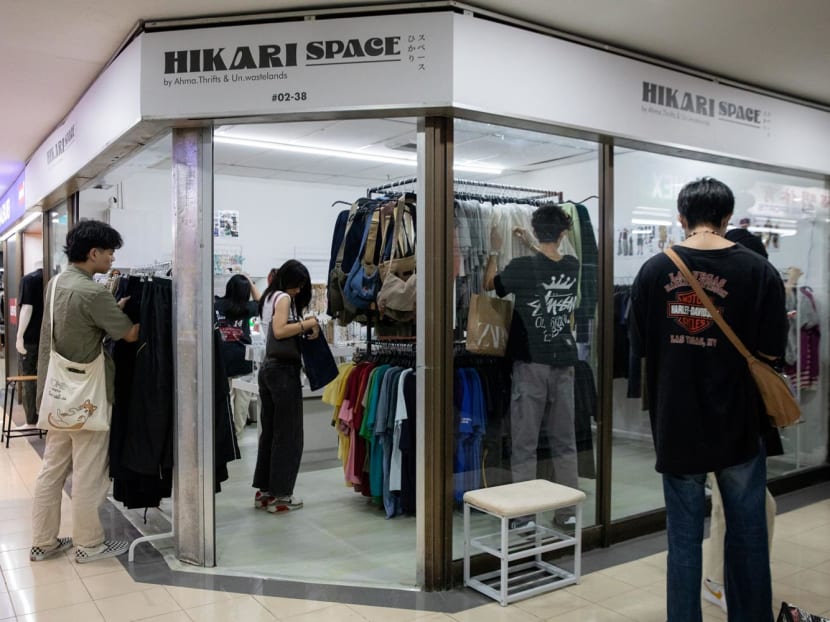When customers walk into Woofie’s Warehouse at Golden Landmark Shopping Complex, they will be surprised by the absence of employees lurking around.
Instead, they are greeted with rows of clothing, from corduroy to denim to linen.
Customers are free to select any item and complete their purchase by scanning one of the QR codes plastered along the walls, with every piece of clothing priced at S$10.
Woofie’s Warehouse is one of several youth-run thrift stores that are leading the charge in sustainable fashion, addressing the growing popularity of thrifting and inspiring a new wave of eco-conscious consumers.
With a keen eye for popular Y2K fashion trends and second-hand clothes, these stores offer a unique shopping experience for customers looking to make a fashion statement while reducing their carbon footprint.
TODAY spoke to three such businesses to get a closer look into their ethos and explore the reasons behind the popularity of thrifting among the younger generation.
WOOFIE’S WAREHOUSE
In 2021, Mr Matthew Tan and Ms Desiree Chang, both 21-year-old undergraduates at the National University of Singapore (NUS), started an online marketplace over Telegram and Instagram called Woofie.co that offers second-hand clothing mainly sourced from Japan.
They would scour overseas websites for such items, pay shipping fees and sift through bundles of clothes.
They then meticulously look for items that are in decent condition, while unwearable and irreparable pieces with defects such as stains, tears or faulty zippers are sent for recycling.
The co-owners define their enterprise as a “hybrid concept between thrift and vintage”.
Mr Tan sees each worn-in item as “a piece with a lot of history”.
“It has a story and it can be rehomed,” Ms Chang added.
They opened their physical store, Woofie’s Warehouse, in April 2023 as an extension to their online page.
They place their trust in customers being responsible enough not to walk away without paying, while making sustainability accessible and affordable to everyone.
“I envisioned this self-service concept of someone chilling, finding a few pieces during their alone time on a random day; an introvert-friendly thrifting space,” Mr Tan said.
The co-owners believe that thrifting has been popularised by influencers on social media who normalised the concept of second-hand clothing, a trend that challenges the conventional norms of the fashion industry.
Mr Tan and Ms Chang make efforts to continue the “cycle” of passing on clothes by allowing customers to use their Telegram channel to resell clothes previously bought from them.
But running a business has not been easy.
Mr Tan is starting his university studies this August, while Ms Chang is a second-year student in Communications and New Media.
“It’s hard to keep an active social life,” Ms Chang confessed.

HIKARI SPACE
Customers who walk into Hikari Space at Queensway Shopping Centre are often people who “consume consciously” and are not just mindlessly browsing through the shelves, the store’s owners believe.
“It’s more of the mindset that people take when they shop. They will hold onto a piece and think, will I wear it, where will I wear it, how often,” said Ms Audrey Hong, a 23-year-old business graduate from the Nanyang Technological University.
She and her fellow co-founder, Ms Shermaine Boey, a 21-year-old student at NUS Business School, have been collaborating at Hikari Space since April this year.
They assembled a team of employees to manage the store, feature full outfits from the available stock, and showcase them on social media.
“In the event that people cannot come down to try on the pieces, we give them an idea of how you can match the colours, the fit and the silhouette,” Ms Hong added.
The store thrives on Y2K fashion trends that remove the restrictions of traditional gender norms of clothings, allowing individuals to explore different styles.
These gender-neutral looks are modelled by both male and female employees.
“Clothes have no gender, right?” Ms Boey quipped.
Hikari Space has also hosted local vendors to sell accessories that match the business’ aesthetics.
“We know how hard it is to have an avenue to sell your items. This also gives our store more versatility, with more items to showcase,” Ms Hong said.
“That’s why our community is so close knitted, we all have the same brain,” Ms Boey added.
Hikari Space also repurposes surplus clothes through events such as warehouse sales and using biodegradable bags at the store, while encouraging customers to come with their own bags.
THE HAMMOCK MARKET
The Hammock Market at the atrium in Aperia Mall is an event where small local businesses and youth-run thrift stores showcase their items in hammocks, instead of on tables and carts as seen at other flea markets.
The Hammock Market came about as it wanted to “inculcate the culture of thrifting” in young adults, said its 30-year-old founder, Ms Ellane Ong.
She had found a gap for “affordable” booths. While renting booths at flea markets typically costs S$100 to S$160 a day on weekends, at the Hammock Market it is only S$58 to S$78.
“With its novelty factor comes challenges,” Ms Ong acknowledged.
For instance, she had difficulties roping in vendors who were unsure of the market’s potential to garner a crowd, while the public may not know if there would be vendors worth checking out.
So she and her team invested in tote bags, offered free jagua tattoo services and spent money on marketing to draw in the crowds.

Ms Ong believes that youths are more receptive to the idea of buying second-hand, especially with fast fashion brands such as H&M and Zara putting in effort to be more eco-friendly.
“These beliefs do get trickled down to young generations as they are in their moulding stage,” she said.




